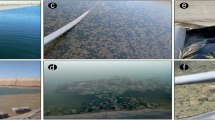Abstract
Phytoplankton biomass and species composition were studied from June to September 1991 at the mouth of four major rivers and in the freshwater (sal. 0 %), the estuarine (sal. 2–10%) and the coastal (sal. 10–12%) zones of Rupert Bay, located at the southeast tip of James Bay, Canada.
A chlorophyll a maximum (5–14 µg 1−1) was observed in the freshwater zone from July to September. Chlorophyll values were low at the mouth of the rivers and in the estuarine and coastal zones (chl a < 1.00 µg 1−1). Diatoms were dominant in the freshwater zone (30–80 % abundance), with flagellates dominating in the estuarine and coastal zones (60–95% abundance). Diversity was low (H′: 1.5–2.5) in the freshwater zone and decreased seaward (H′: 0.5–1.5).
The diatom bloom was composed almost exclusively of the autochthonous planktonic diatom Cyclotella meneghiniana Kütz., which contributed 25–85% of the species composition, and of the subdominant benthic species Diploneis smithii, Navicula lanceolata and Surirella robusta. Peak abundance occurred upstream of the turbidity maximum, in the tidal freshwater zone. In this zone the mean photic depth was 1 m and residence time was from 7 to 8 days during the bloom. Residence time is considered to be the dominant factor controlling the phytoplankton bloom, with light not acting as a limiting factor. The high turbidity due to resuspension and shallow depth of the bay controlled the species composition.
Similar content being viewed by others
References
Anderson, G. F. 1986. Silica, diatoms and a freshwater productivity maximum in Atlantic coastal Plain Estuaries, Chesapeake Bay. Estuar. Coast. Shelf Sci. 22: 183–197.
Cadée, G. C. 1978. Primary production and chlorophyll in the Zaire river, estuary and plume. Neth. J. Sea Res. 12: 368–381.
Conomos, T. J. & D. H. Peterson. 1977. Suspended particle transport and circulation in San Francisco Bay: an overview. In M. Wiley (ed.), Estuarine Processes, vol. II. Academic Press, New York: 82–97.
De Sève, M. 1993. Océanographie biologique de la baie de Rupert: Phytoplancton et Zooplancton. Groupe Environnement Littoral, Rapport à la Vice-présidence Environnement, Hydro-Québec, Montréal, Québec, 68 pp.
Fisher, H. B., E. J. List, J. Imberger & N. H. Brooks. 1979. Mixing in inland and coastal waters. Academic Press, New York, 475 pp.
Fisher, T. R., L. W. Harding, Jr., D. W. Stanley & L. G. Ward. 1988. Phytoplankton, nutrients and turbidity in the Chesapeake, Delaware and Hudson Estuaries. Estuar. Coast. Shelf Sci. 27: 61–93.
Haertal, L., L. Osterberg, H. Curl & P. Kilopark. 1969. Nutrient and plankton ecology of the Columbia River Estuary. Ecology 50: 962–978.
Hansen, D. & M. Rattrey. 1966. New dimensions and estuary classification. Limnol. Oceanogr. 11: 319–325.
Ingram, G. 1977. Océanographie physique de l'estuaire de la baie de Rupert. GIROG, Rapport à la S.E.B.J. Complexe N.B.R. (mandat SEBJ/NBR-E-3). Société de la Baie James, Montréal, Québec, 43 pp.
Jackson, R. H., P. J. Le B. Williams & I. R. Joint. 1987. Freshwater phytoplankton in the low salinity region of the River Tamer Estuary. Estuar. Coast. Shelf Sci. 25: bx299–311.
Levasseur, M. E., J. C. Therriault & L. Legendre. 1984. Hierarchical control of phytoplankton succession by physical factors. Mar. Ecol. Prog. Ser. 19: 211–222.
Lippson, A. J., M. S. Haire, A. F. Holand, F. Jacobs, J. Jensen, R. L. Moran-Johnson, T. T. Polgar & W. A. Richkus. 1979. Environmental atlas of the Potomac estuary. Martin-marietta Corp., Baltimore, Maryland, 279 pp.
Lowe, R. L. 1974. Environmental requirements and pollution tolerance of freshwater diatoms. U.S. Environmental Protection Agency, Cincinnati, Ohio, 660 pp.
Ouellet, Y. 1977. Etude à l'aide d'un modèle mathématique, de la circulation hydrodynamique, de la propagation de la marée et de la distribution de la salinité dans la baie de Rupert. GIROQ-CENTREAU Rapport à la S.E.B.J. Complexe N.B.R. (mandat SEBJ/NBR-E-3). Société de la Baie James, Montréal, Québec, 24 pp.
Peterson, D. H., J. F. Festa & T. J. Conomos. 1978. Numerical simulation of dissolved silica in the San Francisco Bay. Estuar. coast. mar. Sci. 7: 99–116.
Roff, J. C., R. C. Pett, G. F. Rogers & W. P. A. Budgell. 1980. A study of plankton ecology in Chesterfield Inlet, Northwest Territories: an arctic estuary. In V. A. Kennedy (ed.), Estuarine Perspectives. Academic Press, New York: 185–197.
Schuchardt, B. & M. Schirmer. 1991. Phytoplankton maxima in the tidal freshwater reaches of two coastal plain estuaries. Estuar. Coast. Shelf Sci. 32: 187–206.
S. E. B. J. 1978. Complexe Nooaway, Broadback, Rupert. Rapport d'avancement des etudes en date de février 1978 relatives aux possibilités d'installations d'usines hydroélectriques sur les rivières Broadback et Rupert. Société d'Énergie de la Baie James, Montreal, Quebec, 82 pp.
Shaffer, G. P. & M. Sullivan. 1988. Water column productivity attributable to displaced benthic diatoms in wellmixed estuaries. J. Phycol. 24: 132–140.
Shannon, C. E. & W. Weaver. 1949. The mathematical theory of communication. University of Illinois Press, Urbana, 117 pp.
Simard, Y. & L. Legendre. 1977. Complexe N.B.R. Étude sur la baie de Rupert: Océanographie biologique de la baie de Rupert au cours de l'été 1976. GIROQ. (Mandat SEBJ/NBR-E-3). Société de la Baie James, Montréal, Québec, 95 pp.
Stickland, J. D. H. & T. R. Parsons. 1972. A practical handbook of seawater analysis, 2nd edn. Fish. Res. Board Can. Bull. 167: 1–301.
Utermöhl, H. 1958. Zur Vervollkommung der quantitativen Phytoplankton-Methodik. Mitt. Int. Verein. Theor. Angew. Limnol. 9: 1–38.
Veilleux, L., R. G. Ingram & A. Van Der Baaren. 1992. A description of summer physical oceanographic conditions in Rupert Bay (James Bay, Canada). Arctic 45: 258–268.
Author information
Authors and Affiliations
Rights and permissions
About this article
Cite this article
De Sève, M.A. Diatom bloom in the tidal freshwater zone of a turbid and shallow estuary, Rupert Bay (James Bay, Canada). Hydrobiologia 269, 225–233 (1993). https://doi.org/10.1007/BF00028021
Issue Date:
DOI: https://doi.org/10.1007/BF00028021




